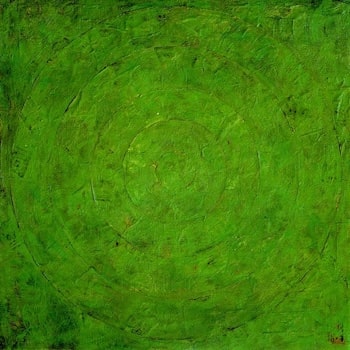Green Target, 1955 by Jasper Johns

Johns created Green Target in 1955. The painting was included in a group show at the Jewish Museum. There the painting caught the attention of Leo Castelli.
Trieste-born Leo Castelli was an art collector and self-described playboy who decided, at the age of 51, to open a gallery in New York. He had begun by selling paintings from his own collection; he
also approached several young artists whose work interested him. In March 1957, after the Jewish Museum show, Castelli went to Pearl Street to invite Rauschenberg to show at his gallery. In passing,
Castelli mentioned that he had seen a painting by someone with the peculiar name of Jasper Johns, and that he would like to meet the artist. "Well, that's very easy," Rauschenberg said, "he's downstairs."
"I walked into the studio," Castelli recalled, "and there was this attractive, very shy young man, and all these paintings. It was astonishing, a complete body of work. It was the most incredible
thing I've ever seen in my life."
For Johns, who did not want to be associated with any particular group of painters, Castelli's gallery was ideal, since it was new and had no specific identity. Castelli showed Johns' Flag
in a group show at his gallery later in 1957, and in 1958 he gave Johns his first one-man show. Here Johns displayed the result of more than three years of sustained effort: his flags, his targets, his
numbers and alphabets. Johns became "an overnight sensation," and was immediately plunged into a critical controversy that continued for several years.
To understand the controversy, one must recall the attitude of the New York art world in the middle 1950s. Abstract Expressionism - that movement which took as its fundamental tenet the necessity
of communicating subjective content through an abstract art - reigned supreme in the city. The importance of Abstract Expressionism was confirmed by the fact that, for the first time in history, an
indigenous American art movement had gained international significance.
The New York art world cherished Abstract Expressionism; it was almost impossible to conceive of anything else, to imagine any other premise for painting. As Rauschenberg said of that time, a young
painter had "to start every day moving out from Jackson Pollock and Willem de Kooning, which is sort of a
long way to have to start from." The burden was very heavy.
At the same time, the second generation of Abstract Expressionist painters were often perceived to have "slavishly imitated" their predecessors. The early shock and excitement of the movement were
gone. "As the art market was glutted with the works of de Kooning's admirers, the real achievements of de Kooning and his generation were becoming obscured." There was a sense of waiting for
something fresh and new, and newly provocative.
Johns provided the provocation. His assured and finely worked paintings of flags and targets offered an alternative to Abstract Expressionism, and reintroduced representation - the recognizable
image - into painting.
